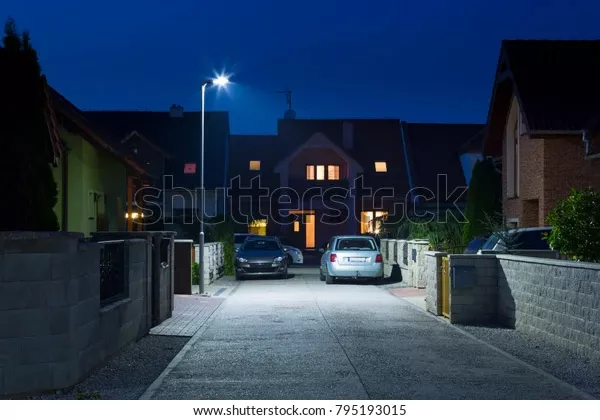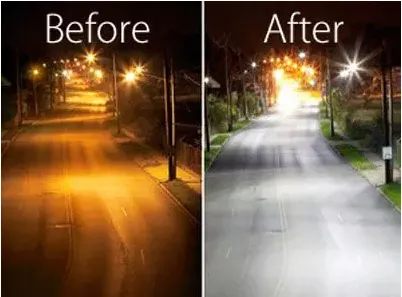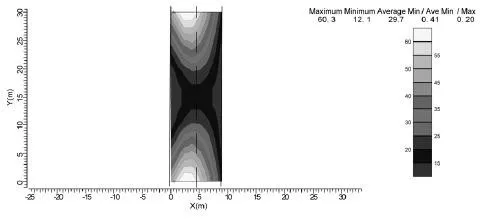Guide to LED High Mast Lights, Why Choose our Led High Mast Lighting?
1909Guide to High Mast led lights, Why Choose our Led High Mast Lighting?
View detailsWondering about what is better between LED and HPS street lights? Here’s a fresh, detailed and updated evaluation you are looking for.


So you are not a lighting engineer or a horticulturist to have an instinctive ability to know the best requirements for outdoor lighting. But you need to know if buying the new LED lighting luminaire justifies its upfront cost. Is it really better than the old sodium street lights you’ve grown up with?
Today, LED street lights are mainstreaming worldwide. Everyone wants to shift to greener alternatives, zero electricity costs and less carbon footprint.
So whether you’re an expert lighting professional, a contractor, a building manager or a homeowner wanting to know more about LED lighting versus HPS lighting, this article is for you.
In this blog, we have laid out the differences in characteristics, performance, efficiencies, costs and warranties of LED and HPS street lights. Read on!

High Pressure Sodium (HPS) street lights are one of the most common street lights you can see today. They produce a distinctively yellow-orange, monochromatic glow.
You can still see many HPS lights for lighting large areas, manufacturing sites, roadways, parks, and parking lots. They are also commonly used as grow lights for plants. But today, HPS street lights are quickly being retrofitted with more efficient and eco-friendly LED lights.
If you’re wondering why a lot of HPS lights haven’t been taken down today, this is because they still present some benefits to the community. Here they are.
But HPS street lights don’t come entirely clean. Here are the drawbacks.
Now let’s move on to the newest type of street lighting today.
Since HPS street lights have high intensity lights, they are best for tall mounting applications like for industrial lighting and security lighting. They are the best options when you need to mount street lights with 15 feet and above heights.
They are not suitable for applications needing high color rendition accuracy, like in retail and commercialize lighting. HPS lights would do poorly on projecting the colors of objects with high precision. If street lights are to be switched on and off frequently, HPS lights are also not appropriate for the job. This is where LED street lights are best at.

An LED street light is a better street lighting option which is highly preferred in today’s struggle towards green living. This is because integrated LED street lights are more energy-saving than other outdoor lights, requiring less maintenance and operation costs.
In fact, they are 50% more efficient than traditional sodium street lights, and can last 20-25 years. This is why majority of the world are shifting towards LED outdoor lights.
LED lamps produce a distinct bluish white glow. Newer LED street lights can produce amber-colored hue or yellow-warm colors which are more animal-friendly with the least light pollution.
LED street lights are best outdoor lighting applications requiring high color rendering accuracy. They can be used for both retail, commercialized and industrial lighting.
Today, you can find solar street lights, LED street lights, All-in-One solar street lights and adjustable LED street lights the best choices for smart, energy efficient and low cost solutions.
Smart LED street lights are equipped with automatic dimming and brightness and you can set different lighting modes depending on your area’s requirements. They are also highly recommended for parks, parking lots, roadway lighting, pathway lighting, pedestrians, gardens, and many more.
Here, we present the different characteristics of HPS street lights and LED street lights.
| Key Interest | Description | Criteria for Street Lights | LED Street Light | HPS Street Light | Verdict |
|---|---|---|---|---|---|
| Color Rendering Index (CRI) | CRI is how the light source reflects the color of an object. | Excellent:75-100: Good: 65-75; Fair: 55-65: Poor: 0-55 | 65 to 95 | 20 to 30 | LED has a pleasing CRI range. |
| Correlated Color Temperature (CCT) | CCT measures how warm or how cold the lighting is. It is expressed in Kelvin (K). | For Street Lights, AMA recommends a CCT value of around 3000K. | 2200K to 6000K | +/-2200K | More options with LED than HPS. |
| ON/OFF (Warm Up Time) | Describes how fast the street light responds to being switched on and off. | Faster warm up time and cool down/restrike time is better. | No warm up or cool down, Instant turn on | Short delay in turning off/ on, 1 to 15 minutes | LED are better. |
| Restrike Time | Instant switch off | 4 to 5 minutes | LED | ||
| Dimming | The ability of a street light to adjust in brightness when not in use. | Larger dimming range is preferred as it’s saving energy consumption | Can Automatic dimming from 100% to 30% to 0.5% | Dimming requires a ballast; can be dimmed up to 50% | LED are larger dimmability range |
| Directionality | The ability of light to focus in one direction. | Street light focusing in one direction is highly desirable. | LEDs illuminate light at only 180 degrees. | Sodium lamps emit light in all directions (360°). | LED are highly directional. |
| Efficiency | It’s the ability of light to illuminate more brightness at less energy and is measured in lumens per watt. | Use higher efficiency light type to offset lesser maintenance and operation cost. | 120 to 180 Lm/W | 80 to 140 Lm/W | LED are more energy efficient. |
| Efficiency Droop | It’s the tendency of lights to lose efficiency at high currents, raising heat emission | Least efficiency droop is better. | Low efficiency droop up to its end of life. Lowest efficiency at 80% | At half of life Emit 90%. At the near end Emit 80%. | Both Good Efficiency Droop |
| Foot Candles Unit: (lumen/sq.ft) | Describes the intensity of a uniform lighting or illuminance of source reaching a 1ft^2 area. | Freeways: 0.6 to 1.1; Local (commercial, Residential): 0.4 to 0.8; Pedestrian/bicycle ways: 2; Alleys: 0.3 to 0.6; Minor Arterials: 0.7 to 1.4; Parking: 5 | LED can better attain the foot candle needed for a desired area | Since HPS are omnidirectional, a large energy needed redirected just to attain the appropriate foot candle for a desired area. also means more energy consumed. | LED |
| Key Interest | Description | Criteria for Street Lights | LED Street Light | HPS Street Light | Verdict |
|---|---|---|---|---|---|
| Visible Light Emissions, Infrared,Ultraviolet | The ability of the light emit visible/optical light, safe and healthy for the human eye . | The light emission must play along the spectrum of visible light (range of 400–700 nm) | LED visible light wavelength ranges from 360 to 950 nm. No Infrared, No Ultraviolet | HPS Visible light wavelength near 589 nm. No Infrared, No Ultraviolet | LED stronger |
| Mercury Content | Mercury contributes to the lamps efficiency and lifespan, but is harmful when exposed to the environment. | Ideally, lights should have minimal to no mercury content so waste disposal is more convenient. | 0 mg, no mercury content | 6mg per 100 Watts | LEDs no mercury |
| Heat Emissions | Heat emission is an energy inefficiency of a lighting system. | Ideally speaking, a lighting system is better if it has minimal to zero heat emission. | LEDs do not emit heat as other street light types. But it still needs a heat sink to prolong its life. | More heat emission. The ballast may either absorb it or be lost in the environment. 15% are likely to be lost by an HPS street light. | LED |
| Cold Tolerance | The ability of the street light to withstand extremely low temperatures. | High heat tolerance is desirable for cold areas such as Canada, Germany, etc. | -40 Degrees Celsius | -40 Degrees Celsius | Both can still work at low temperatures |
| Heat Tolerance | The ability of the street light to withstand extremely high temperatures. | High heat tolerance is desirable for deserts and areas with tropical climates. | 75 to 100 Degrees Celsius | 65 Degrees Celsius | LEDs have higher heat tolerance. |
| Shock Resistance | Indicates how well street lights react to mechanical shocks or wind force. | Since street lights are outdoor lights, they are exposed to harsh conditions. Durable lighting options are therefore preferred. | LED lights are solid state lights (SSLs). Hence they are not easy to damage with any physical shocks. | Fragile as they use glass bulbs | LED |
| Failure Characteristics | This describes the potential failure points of a street lights before the end of its life. | When LEDs dim gradually, it indicates that it’s nearing its end of life. An LED street light usually has a number of emitters in a single luminaire. So when one diode fails, that doesn’t mean the whole LED module should be replaced. | When HPS reaches its cycling phenomenon, the light flickers on and off before failing. | LED | |
| Warranty | LED street light manufacturers usually give a 3 to 8 years warranty. | 1 to 4 years typical warranty | LED | ||
| Life Span | Describes the number of hours the light can be rendered useful. | Longer street light lifespans are better to minimize maintenance and operation costs. | 25,000 hours to 200,000 hours | 10,000 hours to 24,000 hours | LED |
| Upfront Costs | Typical 100W costs $10 to $20 | $5 to $10 for 100W | HPS | ||
| Maintenance | No maintenance cost | Frequent equipment replacements accounts for labor cost, and tooling costs and repair costs | LED |

Yes you can! You simply need to know the wattage of the existing HPS light bulb and know the amount of light brightness in lumens. Then find an LED bulb that can deliver the lumens required.
Here’s a sample High Pressure Sodium to LED Conversion Table:
| Lumens Needed (lm) | Power Draw in Watts HPS | LED |
| 4,500-6,000 | 100 | 30-40 |
| 6,000 | 125 | 40 |
| 7,500-9,000 | 150 | 50-60 |
| 9,000 | 175 | 60 |
| 11,250-12,000 | 250 | 75-80 |
| 15,000 | 320 | 100 |
| 18,000-22,500 | 400 | 120-150 |
For example, you have a 400W HPS light bulb and you want to replace that with an LED light bulb. This means, you can use a 120 Watt LED bulb with 18,000 lumens to replace your 400W HPS light bulb.
From the above analysis, we can now conclude that LED street lights are far better than HPS street lights in a ton of ways.
Cost efficient. Check! Higher and faster ROI. Check! Energy efficient. Check! No apparent pollution created. Check! Smart, innovative and convenient. Check!
Did this definitive analysis enlightened you to switch to outdoor LED lights? Are you willing to replace your existing high pressure sodium street lights with LED street lights?
Depth Analysis of LED Street Light Vs HPS Lamp
A factory in road lighting design project, through a detailed program of research and investigation, the whole plant road lighting for the project all use the LED light source. The basic situation of the project are as follows:
(1)Project Location: North China.
(2)The total length of the road the whole plant: about 9km.
(3)Road width: 9m.
(4)Street light pole height: 8m.
(5)Street pick arm length: arm 1m.
(6)Street maximum spacing: 30m.
(7)Street layout: single-row layout.
As a new type of light source, the initial application of industrial lighting project, we must make them irreplaceable research, so the road lighting design, respectively, for the high pressure sodium lamp and LED light source. Contrast the different design of light source , we hope to get the truth results of the feasibility study.
Table 1 shows the design data, according to the data in Table 1 can be obtained from the illumination analysis and economic analysis respectively and get a reasonable conclusion.

Illumination Analysis: Philips Calculux Road software was used to make a street light design model, the report as following:




According to the results of software analysis reports can be obtained illuminance value: 120W LED street light, light height 8m, 30m spacing in the next, on the road 9m wide, ground maximum illumination 51.8lux, minimum illumination of 12.8lux, average illuminance 25lux ; 250W high pressure sodium street light, light height 8m, 30m spacing in the next, on the road 9m wide, ground maximum illumination 60.3lux, minimum illumination of 12.1lux, the average intensity of 29.7lux. According to the industry and the national standards, the plant trunk roads must not drop below ground level illumination 10lux, so whether it is 120W LED street light or 250W high pressure sodium street light on the illuminance values meet standards.
Economic Analysis:
According to Table 1 “LED light source, high pressure sodium light source design data comparison”, Economic analysis can be obtained as shown in Table 2 results:

As can be seen from Table 2, due to the high price of LED street light, the first purchase costs are 40 percent more than high pressure sodium street light, less than half of high pressure sodium light source LED street light energy consumption costs higher, according to consider running for five years , LED light source is still higher than the total cost of high pressure sodium light source to nearly 10 percent. This shows that in the short term in the cost of LED lights still at a low level.
However, in the interest of the economy at the same time, we can not ignore the rigid demands of energy conservation. From the international environment, climate change, energy security and other global issues highlights, low-carbon economic development has become the strategic high ground. From the domestic situation, the Chinese government promised that by 2020, carbon dioxide emissions per unit of GDP fell from 40% to 50% higher than in 2005, which also requires a strenuous effort. Meanwhile reduction targets established in the industry is also clear that the total amount of 5 million tons of standard coal to achieve energy “Twelve Five” period, the overall energy consumption yuan output value of industrial enterprises reached 5.8 percent decline. As can be seen from Table 2, the choice of LED lights in five years can reduce carbon dioxide emissions of more than 600 tons, equivalent to saving more than 240 tons of standard coal, although this more than 240 tons and 5 million tons of goals far, but a short step a thousand miles 500 tons goal is to accumulate up by a little bit of emissions, use of LED lights is the link which can not be ignored.
Guide to High Mast led lights, Why Choose our Led High Mast Lighting?
View detailsHow to dissipate heat from LED lights?LED Chip Heat Dissipation
View detailsTypical Applications of Led High Mast Light, High Mast Lighting Systems
View details
HelloPlease log in